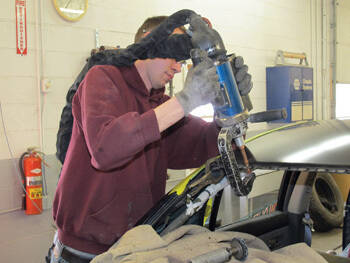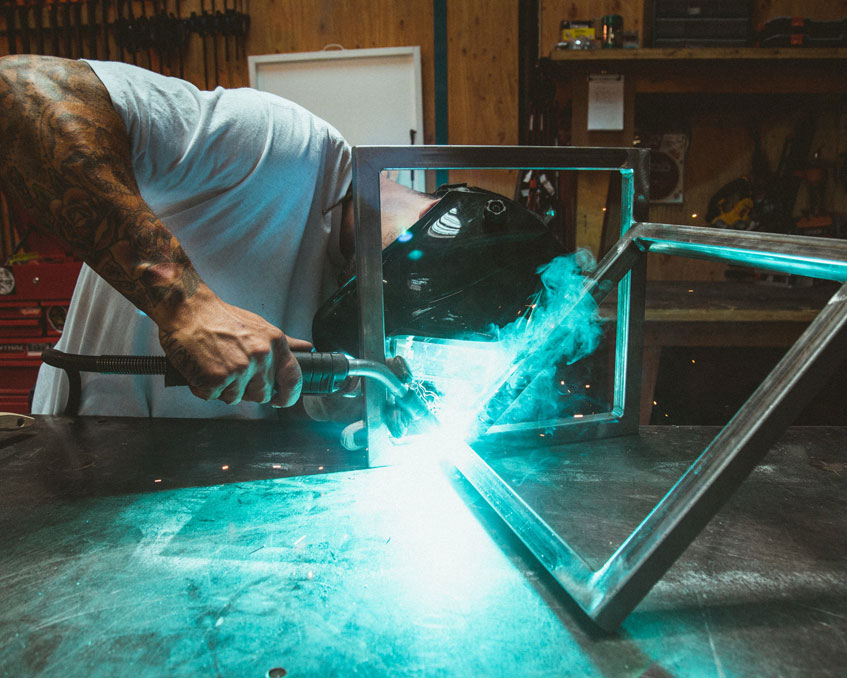Everything about Welding: Secret Insights Into Techniques and Best Practices for Success
Welding incorporates a selection of methods, each matched for certain materials and applications. Recognizing these methods, such as GMAW, SMAW, and TIG, is necessary for accomplishing optimal results. The right tools and security methods can not be overlooked. As prep work and fixing play essential functions in the welding procedure, grasping these elements can significantly enhance the quality of the last product. What are the essential factors that assure a successful weld?
Comprehending Various Welding Methods
Welding strategies include a range of approaches, each fit to specific applications and products. Amongst one of the most common techniques are Gas Steel Arc Welding (GMAW), Shielded Metal Arc Welding (SMAW), and Tungsten Inert Gas Welding (TIG) GMAW, also called MIG welding, is popular for its rate and flexibility, making it optimal for slim products. SMAW, or stick welding, is preferred for its simplicity and efficiency in outdoor atmospheres, specifically with thicker steels. TIG welding provides accuracy and control, making it ideal for elaborate work and non-ferrous metals (Welding). Each strategy has its unique benefits and factors to consider, permitting welders to select the best method based upon the job's requirements, material type, and desired results. Understanding these methods is vital for successful welding
Essential Welding Devices and Devices
While numerous welding strategies call for specific skills, the best devices and tools are similarly necessary for attaining top quality outcomes. Essential welding equipment includes welding machines, which differ relying on the technique-- such as MIG, TIG, or stick welding. Protective gear, including handwear covers, aprons, and headgears, warranties safety and security and comfort during the procedure. In enhancement, clamps and fixtures assist protect materials in position, guaranteeing accuracy in welds. Consumables like welding poles, cable, and protecting gas are likewise crucial elements that influence the quality of the weld. Devices such as cutters and mills facilitate surface area preparation and post-weld ending up, contributing to a professional end result. Buying high-grade devices ultimately improves the performance and efficiency of welding projects.
Safety Practices in Welding
Proper safety and security practices are vital in the welding sector to safeguard employees from prospective risks. Welders should put on proper individual protective devices (PPE), including helmets with appropriate shading, gloves, and flame-resistant clothes. Appropriate ventilation is important to reduce direct exposure to damaging fumes and gases created during the welding process. In addition, workers need to be trained in the right handling of welding tools to avoid mishaps. Fire precaution, such as keeping combustible materials far from the welding location and having fire extinguishers conveniently offered, are required. Routine examinations of equipment and offices can aid identify prospective threats before they result in mishaps. By sticking to these safety and security practices, welders can create a more secure working setting and minimize risks related to their profession.
Preparing Products for Welding
Preparing materials for welding is a crucial step that substantially affects the quality and integrity of the end product (Montana Mobile Welding and Repair). Proper preparation includes cleaning up the surfaces to remove impurities such as oil, corrosion, and dust, which can compromise the weld. Strategies such as grinding, fining sand, or making use of solvents are generally used to attain a tidy surface. Additionally, making certain that the products mesh comfortably is important; gaps can bring about weak welds. It's additionally vital to take right into account the alignment and positioning of the elements, as this will influence the convenience of welding and the final outcome. Choosing the appropriate filler product and making sure compatibility with the base steels is vital for accomplishing solid, durable welds.
Tips for Achieving High-Quality Welds
Attaining top quality welds calls for attention to detail and adherence to finest techniques throughout the welding process. Correct joint preparation is essential, making sure surfaces are totally free and clean from pollutants. Choosing the appropriate filler material and welding technique based on the base steels is critical for excellent bonding. Maintaining consistent traveling rate and angle while welding can advertise and stop flaws harmony. Additionally, managing warm input is crucial; excessive warmth can lead to bending and weakened joints. Regularly inspecting the welds during the process enables for instant modifications if needed. Employing ideal post-weld therapies, such as cleaning and stress alleviation, can improve the toughness and integrity of the weld, inevitably making certain an effective end result.
Fixing Common Welding Issues
Welding usually offers difficulties that can affect the high quality and integrity of the last product. Typical problems such as porosity, irregular weld beads, and overheating can develop, each calling for particular troubleshooting strategies. Recognizing these issues is necessary for welders to enhance their abilities and accomplish perfect results.
Porosity Problems Described
Although porosity can typically be ignored, it remains a critical problem in welding that can jeopardize the integrity of a completed item. Porosity refers to the existence of small gas pockets within the weld grain, which can lead and deteriorate the joint to premature failing. This problem commonly occurs from impurities, dampness, or incorrect securing gas insurance coverage during the welding process. To alleviate porosity, welders ought to verify that the base materials are completely dry and clean, use suitable securing gases, and keep regular welding specifications. Frequently checking the devices and setting can also help identify prospective problems before they materialize in the weld. Resolving porosity successfully is necessary for attaining strong, long lasting welds that fulfill quality criteria.

Inconsistent Weld Beans
Irregular weld grains can greatly influence the top quality and strength of a finished item. Different variables add to this problem, consisting of incorrect travel rate, inaccurate amperage settings, and inconsistent electrode angles. When the welder relocates as well promptly, a grain might appear slim and lack infiltration, while relocating too gradually can cause too much build-up. Additionally, making use of the incorrect amperage can result in either damaging or excessive spatter, both of which compromise weld stability. The welder's technique, such as inconsistent lantern motion, can also cause irregular grain appearance. To minimize these problems, welders need to focus on keeping steady, regulated motions and ensuring appropriate equipment setups to accomplish uniformity in their welds. Uniformity is essential to attaining dependable and solid welds.
Getting Too Hot and Bending Issues
Excessive warm throughout the welding process can bring about significant getting too hot and deforming problems, affecting the structural integrity of the workpiece. These issues frequently manifest as distortion, which can jeopardize positioning and fit-up, making more assembly challenging. Variables adding to overheating include the selection of welding criteria, such as voltage and take a look at here now trip speed, in addition to the kind of product being welded. To alleviate these concerns, welders should maintain regular traveling rate and appropriate heat view it input while keeping an eye on the work surface temperature. Additionally, preheating or post-weld heat treatment can help minimize stress and anxieties brought on by fast air conditioning - Belgrade. Normal evaluation and adherence to finest practices are important in stopping getting too hot and making sure the durability and reliability of bonded structures
Frequently Asked Inquiries
What Are the Profession Opportunities in the Welding Sector?
The welding industry uses diverse career possibilities, including placements as welders, examiners, educators, and designers. Specialists can operate Source in manufacturing, building, aerospace, and auto fields, profiting from solid demand and affordable salaries in numerous functions.
Just How Can I Boost My Welding Rate Without Sacrificing Top Quality?
To enhance welding speed without giving up quality, one must practice efficient techniques, maintain devices, maximize setups, and improve hand-eye control. Regular training and looking for responses can also greatly add to accomplishing much faster, high-quality welds.
What Certifications Are Offered for Welders?
Countless certifications exist for welders, including those from the American Welding Culture (AWS), the National Facility for Construction Education And Learning and Research (NCCER), and different industry-specific companies. These qualifications enhance employability and demonstrate skill effectiveness.
Exactly How Does Welding Impact the Characteristics of Metals?
Welding influences the residential or commercial properties of metals by changing their microstructure, which can cause changes in firmness, stamina, and ductility. Warm input and air conditioning prices during the process considerably impact these product characteristics.
Can I Weld Dissimilar Metals With Each Other?
